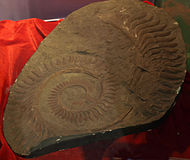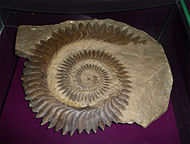User:Pyanh/旋齿鲨
| 這是Pyanh的用户页。用户沙盒是用户页的子頁面,属于用户的測試區,不是維基百科條目。 您可以直接创建自己的沙盒,也能在创建用户子頁面時,添加 {{User sandbox notice}}作為沙盒使用。公用沙盒:主沙盒 | 使用指南沙盒一、二 | 模板沙盒 | 更多…… 外觀選項: 用字選項: |
| 旋齿鲨 化石時期: 石炭纪晚期至三叠纪早期 |
|---|
| 科學分類 |
|
|
| image = Helicoprion Bessonovi2.jpg
| image_width = 250px
| image_caption = Toothwhorl of H. bessonovi
| image2 = Helicoprion bessonovi cropped.png
| image2_width = 250px
| image2_caption = Artist's reconstruction of H. bessonovi
per latest theory
| regnum = Animalia
| phylum = Chordata
| classis = Chondrichthyes
| subclassis = Holocephali
| ordo = †Eugeneodontida
| familia = †Agassizodontidae
| genus = †Helicoprion
| genus_authority = Karpinsky, 1899
| type species = Helicoprion bessonovi
| subdivision_ranks = Species
| subdivision =
- H. bessonovi
- H. davish
- H. ferrieri
- H. ergasaminon
- H. jingmenense
- H. mexicanus
- H. nevadensis
- H. sierrensis
}}
Helicoprion is a long-lived genus of extinct, shark-like[1] eugeneodontid holocephalid fish. Almost all fossil specimens are of spirally arranged clusters of the individuals' teeth, called "tooth whorls." Helicoprion first arose in the oceans of the late Carboniferous 310百萬年前, survived the Permian–Triassic extinction event, and eventually became extinct during the Early Triassic, 250百萬年前. The closest living relatives of Helicoprion (and other eugeneodontids) are the chimaeras.
Palaeobiology
[编辑]Nature of the tooth-whorl
[编辑]Up until 2013, the only known fossils of this genus on record were their teeth, which were arranged in a "tooth-whorl" strongly reminiscent of a circular saw. As the skeletons of chondrichthyid fish are made of cartilage, including those of Helicoprion and other eugeneodonts, the entire body disintegrates once it begins to decay, unless exceptional circumstances preserve it. It was not until the discovery of the skull of a related genus of eugeneodont, Ornithoprion, that it was realized that the tooth-whorl was in the lower jaw. The tooth-whorl represented all of the teeth produced by that individual in the lower jaw, in that as the individual grew, with the older, smaller teeth being moved into the center of the whorl by the appearance of larger, newer teeth. Models of Helicoprion's tooth-whorl have been made. Author of the 1994 book Planet Ocean: A Story of Life, the Sea, and Dancing to the Fossil Record, author Brad Matsen and artist Ray Troll describe and depict an example. They say that there were no teeth in the animal's top row besides the crushing teeth for the whorl to cut against. The two envision the living animal to have a long and very narrow skull, creating a long nose akin to the modern-day goblin shark. According to their studies, the fossils that have been found are essentially a growth ring, as each set of new teeth pushes the previous set into the whorl. The images that Troll has devised are an educated guess at best. Helicoprion's true physical identity remained hidden in 280-million-year-old rocks.[2] Comparisons with other eugenodontids suggest that Helicoprion may have grown up to 3—4米(9.8—13.1英尺) long.
For over a century, it was not certain where the tooth-whorl was located in the lower jaw. Older reconstructions placed the whorl in the front of the lower jaw. A 2008 reconstruction, created by Mary Parrish under the direction of Robert Purdy, Victor Springer and Matt Carrano for the Smithsonian, places the whorl deeper into the throat,[3] although other studies did not accept this conclusion.[4][5] A 2013 study based on new data places the tooth-whorl at the back of the jaw, where the tooth-whorl occupied the entire mandibular arch.[6]
In the article, "Helicoprion in the Anthracolithic (Late Paleozoic) of Nevada and California, and its Stratigraphic Significance", author Harry E. Wheeler describes another Helicoprion fossil, based on the species H. sierrensis, collected by J. H. Menke, that once resided in the University of Nevada, Mackay Museum in 1931. (The fossil's current location is not known) According to Meller, Helicoprion’s mouth is its most distinct trait. The mouth consists of a whorl separated into 3 ¼ volutions. The biggest diameter is about 170毫米(6.7英寸). The whorls have a separation of about 1毫米(0.039英寸) in the first volution, and it goes to about 8毫米(0.31英寸) at the largest whorl displayed. The specimen has a total of about 32 teeth in the first volution, 36 in the second and 41 in the last. The teeth at the end of the first volution are about 7毫米(0.28英寸) long and measure about 2.4英寸(61毫米) width reaching about 40毫米(1.6英寸) long and 9.5 wide at the end of the third. The teeth are symmetrically opposed to one another.[7]
Additionally, other extinct fish, such as onychodontiformes, have analogous tooth-whorls at the front of the jaw, suggesting that such whorls are not as big of an impediment to swimming as suggested in Purdy's hypothesis. While no complete skulls of Helicoprion have been officially described, the fact that related species of chondrichthyids had long, pointed snouts suggests that Helicoprion did as well.
Distribution
[编辑]Fossils of Helicoprion species first appear in Upper Carboniferous marine strata, proliferate greatly during the Permian, and eventually disappear during the Early Triassic. Fossils have been found in the Ural Mountains, Wandagee Mountain of Western Australia, China[8] (together with the related genera Sinohelicoprion and Hunanohelicoprion), and Western North America, including the Canadian Arctic, Mexico, Idaho, Nevada, Wyoming, Texas, Utah, and California. Due to the fossils' locations, it is speculated that the various species of Helicoprion lived off the southwestern coast of Gondwana, and later, Pangaea.
Species
[编辑]H. bessonowi
[编辑]Helicoprion was first described by Alexander Karpinsky in 1899 from a fossil found in Artinskian age limestones of the Ural mountains.[9] Karpinsky named the type species Helicoprion bessonowi. Oliver Perry Hay originally described the species
H. ferrieri
[编辑]
Helicoprion ferrieri was originally described as a species of the genus Lissoprion in 1907, from fossils found in the Phosphoria Formation of Idaho. An additional specimen, tentatively referred to H. ferrieri was described in 1955. That specimen was found in Wolfcampian age quartzites exposed on China Mountain, six miles southeast of Contact, Nevada. The 100毫米(3.9英寸) wide fossil consists of 1 ¾ whorls and about 61 preserved teeth. Due to weathering the rest of the fossil was lost and the preserved section is distorted from slippage of the host rock.[9]
H. jingmenense
[编辑]Helicoprion jingmenense was described from of a nearly complete tooth whorl with 41⁄3 volutions (part and counterpart) found in the Lower Permian Qixia Formation of Hubei Province, China. The specimen is very similar to H. ferrieri and H. bessonowi, though, it differs from the former by having teeth with a wider cutting blade, and a shorter compound root, and differs from the latter by having fewer than 39 teeth per volution.[10]
H. nevadensis
[编辑]One of two Helicoprion species described by Harry, E Wheeler in 1939, H. nevadensis is based on a single partial fossil found in 1929 by Elbert A Stuart.[11]
Gallery
[编辑]-
Outdated reconstruction of Helicoprion bessonovi
-
Helicoprion ferreri, alternative restoration of eugeneodontid "shark" with short rostrum
-
Lower jaw of Helicoprion bessonovi
-
Spiral denture of Helicoprion
References
[编辑]- ^ http://science.nbcnews.com/_news/2013/02/27/17118881-ancient-shark-relative-had-buzzsaw-mouth?lite
- ^ Brad Matsen and Ray Troll. Planet Ocean: A Story of Life, the Sea, and Dancing to the Fossil Record. October 25, 2012.
- ^ Robert W. Purdy. The Orthodonty of Helicoprion. National Museum of Natural History. Smithsonian Institution: 1. February 29, 2008 [August 7, 2009].
- ^ Lebedev, O.A. A new specimen of Helicoprion Karpinsky, 1899 from Kazakhstanian Cisurals and a new reconstruction of its tooth whorl position and function. Acta Zoologica. 2009, 90: 171–182. ISSN 0001-7272. doi:10.1111/j.1463-6395.2008.00353.x.
- ^ Brian Switek. Unraveling the Nature of the Whorl-Toothed Shark. Laelaps. Wired: 3. February 29, 2008 [September 23, 2012].
- ^ Tapanila, L.; Pruitt, J.; Pradel, A.; Wilga, C.D.; Ramsay, J.B.; Schlader, R.; Didier, D.A. Jaws for a spiral-tooth whorl: CT images reveal novel adaptation and phylogeny in fossil Helicoprion. Biology Letters. 2013, 9 (2): 20130057. doi:10.1098/rsbl.2013.0057.
- ^ Harry E. Wheeler. Helicoprion in the Anthracolithic (Late Paleozoic) of Nevada and California, and it’s Stratigraphic Significance. October 25, 2012.
- ^ Chen, XiaoHong; Long Cheng; KaiGuo Yin. The first record of Helicoprion Karpinsky (Helicoprionidae) from China. Chinese Science Bulletin. August 2007, 52 (16): 2246–2251. doi:10.1007/s11434-007-0321-y.
- ^ 9.0 9.1 Larson, E. R.; Scott, J. B. Helicoprion from Elko County, Nevada. Journal of Paleontology. 1955, 29 (5): 918–919.
- ^ Chen, XiaoHong, Long Cheng, and KaiGuo Yin. The first record of Helicoprion Karpinsky (Helicoprionidae) from China. Chinese Science Bulletin. 2007, 52 (16): 2246–2251. doi:10.1007/s11434-007-0321-y.
- ^ Wheeler, H. E. Helicoprion in the Anthracolithic (Late Paleozoic) of Nevada and California, and it’s Stratigraphic Significance (PDF). Journal of Paleontology. 1939, 13 (1): 103–114.




